
Experimental Gravitation
Springer International Publishing (Verlag)
978-3-030-95595-3 (ISBN)
lt;p>Fulvio Ricci is Full Professor of Experimental Physics at the University of Rome, La Sapienza. He started his scientific career working in the Gravitational Wave (GW) group of Professor E. Amaldi at Rome University. For more than fifteen years, he was at CERN installing and operating the 2300 kg GW detector EXPLORER, which achieved the sensitivity goal of an h~10-19 GW burst 1 ms in duration. In 1995, he became Data Analysis Coordinator for the VIRGO project, a collaborative effort between the two funding agencies INFN-Italy and CNRS-France, for the construction of a 3-km laser interferometer for detecting GWs. From 2007 to 2014, he served as INFN Italian Coordinator of VIRGO, subsequently becoming international collaboration's Official Spokesperson from 2014 to 2017. Nowadays, he is involved in the Einstein Telescope project devoted to the construction of the new generation of GW detectors on the Earth.
Massimo Bassan is Associate Professor of Physics in the Department of Physics at the University of Rome, Tor Vergata. He graduated from Sapienza with E. Amaldi and G. Pizzella, developing the first Italian prototype interferometer for gravitational waves. He received his Ph.D. from Stanford University, working with W.M. Fairbank and then spent many years developing and operating cryogenic resonant antennas. He is presently involved with LISA, the space-based gravitational wave detector, as well as with a laboratory experiment `` Liquid Activated Gravity" using a double torsion pendulum.Classical Gravity.- Keplerian dynamics; Multipole expansion.- Tides.- Active, passive mass. -Torsion Pendulum: the oldest physics experimental tool, operation, strategies, analytic model.- The Equivalence Principle: Weak, Einstein and strong EP, experimental tests. - Principles of metric theories: LLI and LPI and experimental verifications; the red shift.- Schiff's conjecture.- Gravity Tests at 1PN: recap of GR equations.- WFSM approximation, classical tests of GR.- Gravitoelectromagnetism and its tests.- Gravity and PPN.- The PPN formulation of metric theories.- Solar System tests and limits on PPN parameters.- Gravitational Waves (GW): GW in GR and in other theories; emission; sources; signals.- GW Detectors: Interferometers.- Data Analysis.- Pulsars and GR.- Space detectors of GW Sagnac effect. GPS. Modulation. Feedback. FabryPerot.
| Erscheinungsdatum | 05.08.2022 |
|---|---|
| Reihe/Serie | Lecture Notes in Physics |
| Zusatzinfo | XXII, 430 p. 171 illus., 139 illus. in color. |
| Verlagsort | Cham |
| Sprache | englisch |
| Maße | 155 x 235 mm |
| Gewicht | 639 g |
| Themenwelt | Mathematik / Informatik ► Informatik ► Datenbanken |
| Naturwissenschaften ► Physik / Astronomie ► Angewandte Physik | |
| Naturwissenschaften ► Physik / Astronomie ► Theoretische Physik | |
| Schlagworte | Data Analysis • Experimental Gravitation Textbook • experimental verification • General relativity • Gravitational wave detection • Gravitoelectromagnetism • Interferometers • pulsar timing array • Space-based Detectors • Space-borne Gravitational Wave Detectors • Torsion Pendulum |
| ISBN-10 | 3-030-95595-8 / 3030955958 |
| ISBN-13 | 978-3-030-95595-3 / 9783030955953 |
| Zustand | Neuware |
| Informationen gemäß Produktsicherheitsverordnung (GPSR) | |
| Haben Sie eine Frage zum Produkt? |
aus dem Bereich


